flute
All scores that include a part for at least one flute.
Hauptmann - Lieder - Voice, Violin/Flute, Piano
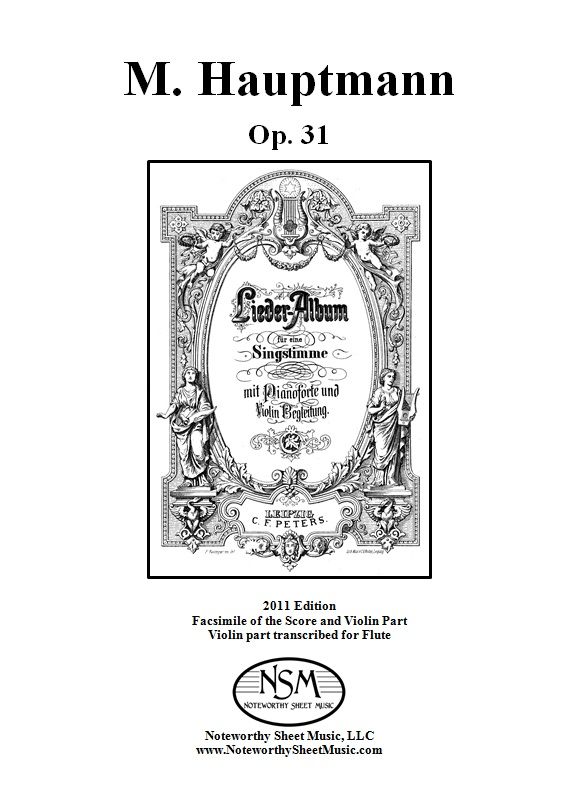 Meerfahrt, Nachtgesang, and Der Fischer, Op.31, by M. Hauptmann
Meerfahrt, Nachtgesang, and Der Fischer, Op.31, by M. Hauptmann
Facsimile Edition plus a Transcription of the violin part for Flute by C.A.Vater
Score for Violin, Voice, & Piano, Violin Part, and Flute Part, PDF $18.75
Moritz Hauptmann (1792-1868) was a renowned music theorist, pedagogue, violinist, and composer. In 1842, at Mendelssohn's recommendation, he was appointed cantor at the Thomasschule and professor of composition at the newly founded Leipzig Conservatory. Hauptmann published a major scholarly work on music theory in 1853, "Die Natur der Harmonik und Metrik" (The Nature of Harmony and Meter), as well as some 60 compositions.
Hauptmann's Op.31 comprises three lovely songs scored for voice with accompaniment of violin and piano: No.1, Meerfahrt (Sea Voyage); No.2, Nachtgesang (Night Song); and No.3, Der Fischer (The Fisherman). The vocal range extends from B3 to G5, and thus is well-suited for mezzo-soprano. These pieces were published by C. F. Peters as part of a larger volume, now in the public domain, entitled "Lieder-Album für eine Singstimme mit Pianoforte und Violin Begleitung". Our edition contains an "enhanced" facsimile of the original, plus a new transcription of the violin part for flute created using a modern music notation program. The three songs may be performed with comparable gratification utilizing the accompaniment of either violin or flute, along with the voice and piano.
Score, 15 pages; Violin part, 5 pages; Flute part, 5 pages; Total, 29 pages.
PreviewHaydn - Adagio from Sym. No.24 - Flute & Piano
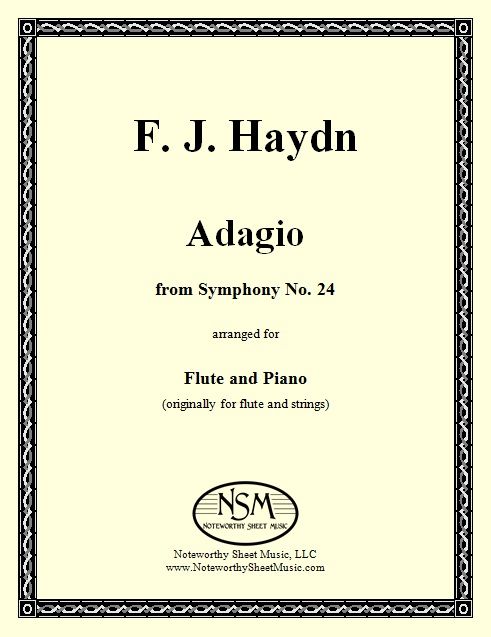 Adagio from Symphony No. 24, by F. J. Haydn
Adagio from Symphony No. 24, by F. J. Haydn
Arranged for Flute and Piano by John W. Pratt
Flute Part and Piano Score, PDF $6.00
Franz Joseph Haydn (1732-1809) wrote his Symphony No. 24 in 1764. The second movement is a beautiful Adagio for solo flute accompanied by strings, with a place for a cadenza. We offer here a piano transcription of the string accompaniment, with appropriate adaptations in sonority, and the flute part with a written cadenza based closely on Haydn's material and style. Players will find the resulting one-movement flute sonata both affecting and highly rewarding.
Flute part, 2 pages; Flute & Piano score, 4 pages; Total, 10 pages.
Preview======================================================
We also offer a professionally-printed hard copy edition of the Haydn Adagio for $13.49 plus a $5.95 shipping and handling fee. Due to prohibitively high international shipping rates, we ship print editions only to addresses in the USA. Please use the Contact Us form to let us know which hard copy publication(s) you would like to purchase, along with your email contact information and USPS mailing address. We will then send you a PayPal invoice for the sale and, once we receive notice from PayPal that you have paid for the item(s), we will ship your music to the address provided for delivery in 7-10 business days.
Haydn - Adagio, Quartet Op.20, No.5 - Fl & Pf
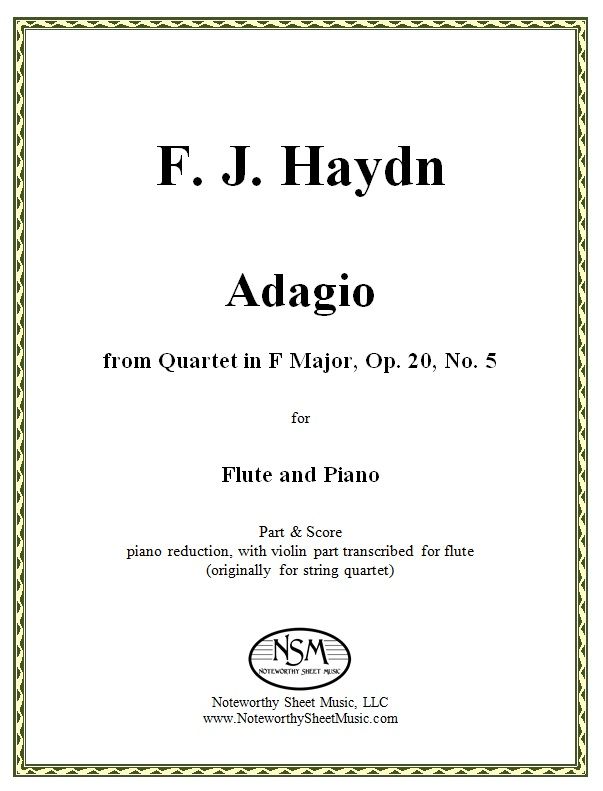 Adagio from Quartet in F Major, Op.20, No.5, by F. J. Haydn
Adagio from Quartet in F Major, Op.20, No.5, by F. J. Haydn
Arranged for Flute and Piano by John W. Pratt
Flute Part and Piano Score, PDF $10.00
The third movement of Haydn's string quartet Opus 20, No. 5 is an Adagio with a simple melody that is treated to delightful filigreed elaboration and obbligato decoration by the violin. Although more complex quartet movements are typically unsuited to transcription, in this beautiful Adagio the soloistic nature of the violin part and the simplicity of the lower string parts lend themselves very well to an arrangement for flute and piano, as in the fine transcription we offer here.
Flute part, 3 pages of music; Piano score, 7 pages of music; Total, 14 pages.
PreviewHaydn - Early Sonatas - arr. as Wind Duos
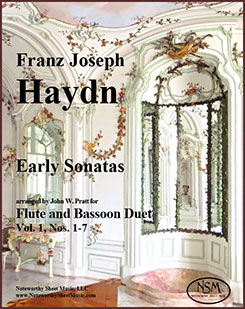 Early Sonatas, by Franz Joseph Haydn
Early Sonatas, by Franz Joseph Haydn
Arranged as Woodwind Duets by John W. Pratt (originally for keyboard)
Even the earliest of Franz Joseph Haydn’s keyboard sonatas have great rhythmic variety and vitality, and are delightful when played with verve. They are mostly in two voices, and even where not, their early classical harmonies are easily conveyed by two instruments. They incorporate few pianistic effects and lie comfortably within range for flute or oboe and bassoon or clarinet, and thus make natural woodwind duets of lively, interesting music. All these editions include a score and parts. Those wishing to consult the keyboard editions of the Haydn sonatas, from which Mr. Pratt created his arrangements, can find them at imslp.org. (Adapted from J. W. Pratt’s preface to the edition.)
Cover image “Decorations of the Sala Terrena, Eszterházy Palace in Fertőd, Hungary“ by Monyesz, Creative Commons Attribution-Share Alike 3.0 Unported license.
--------------------------------------------------------------------------------
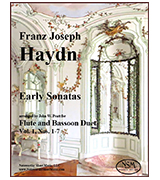 This edition includes seven of Haydn's early keyboard sonatas arranged as duets for flute and bassoon. John Pratt's creation of these duets was inspired by a desire to offer two of his music colleagues some new music to enjoy, as they had exhausted their available flute and bassoon duo repertoire. These duets work nicely for winds and are fun to play. For a sense of how they sound when played by flute and bassoon, click below to listen to a computer-generated audio excerpt: the first 45” of the recording come from the Andante of Sonata 5 (Hob. XVI:11), followed by 25” of the Sonata 6 (Hob. XVI:10) Presto. Alternatively, the flute part can be played on oboe, making these sonata arrangements nicely amenable to oboe and bassoon duos as well.
This edition includes seven of Haydn's early keyboard sonatas arranged as duets for flute and bassoon. John Pratt's creation of these duets was inspired by a desire to offer two of his music colleagues some new music to enjoy, as they had exhausted their available flute and bassoon duo repertoire. These duets work nicely for winds and are fun to play. For a sense of how they sound when played by flute and bassoon, click below to listen to a computer-generated audio excerpt: the first 45” of the recording come from the Andante of Sonata 5 (Hob. XVI:11), followed by 25” of the Sonata 6 (Hob. XVI:10) Presto. Alternatively, the flute part can be played on oboe, making these sonata arrangements nicely amenable to oboe and bassoon duos as well.Preview: Vol.1, Nos. 1-7, Flute and Bassoon
--------------------------------------------------------------------------------
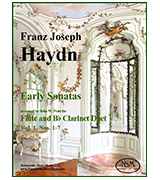 ►Early Haydn Sonatas arranged by John W. Pratt as Duets for Flute and B-flat Clarinet, Vol. 1, Nos. 1-7
►Early Haydn Sonatas arranged by John W. Pratt as Duets for Flute and B-flat Clarinet, Vol. 1, Nos. 1-7
Preview: Vol.1, Nos. 1-7, Flute and Clarinet
Haydn - Fantasia in C Major - Flute & Alto Flute
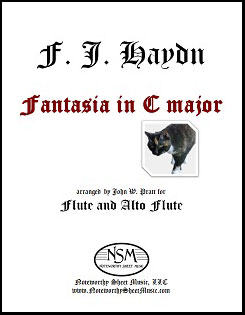 Fantasia in C major, by F. J. Haydn
Fantasia in C major, by F. J. Haydn
Arranged as a Duet for Flute and Alto Flute by John W. Pratt
Flute Part, Alto Flute Part, and Score ― PDF $12.99
Fantasia in C major (Op.58; Hob. XVII:4) was written by Haydn in 1789 for the pianoforte. Based on a folk song about a farmer's wife chasing her cat, one can easily imagine in the music kittenish scampering, stealthy approaches, unexpected pounces, and mad chases with abrupt changes of direction. The style and playfulness of the piece are beautifully suited to the agility and sparkle of flutes. The transcription is able to capture the feel Haydn intended, with new coloring, while at the same time affording flutists the joy of experiencing the work first-hand. (adapted from JWP's foreword to the edition)
Please click the Preview button to see p1-2 of the mini-Score (in concert pitch). After opening the file, adjust the orientation using "View - Rotate View - Clockwise" in your pdf reader program.
Flute part, 6 pages; Alto Flute part, 7 pages; Mini-score, 6 pages; Total, 22 pages.
PreviewHaydn - Fantasia in C Major - Flute & Clarinet
 Fantasia in C major, by F. J. Haydn
Fantasia in C major, by F. J. Haydn
Arranged as a Duet for Flute and Clarinet by John W. Pratt
Flute Part, A Clarinet Part, and Mini-Score ― PDF $12.99
Fantasia in C major (Op.58; Hob. XVII:4) was written by Haydn in 1789 for the pianoforte. Based on a folk song about a farmer's wife chasing her cat, one can easily imagine in the music kittenish scampering, stealthy approaches, unexpected pounces, and mad chases with abrupt changes of direction. The style and playfulness of the piece lend themselves well to flute and clarinet. The transcription is able to capture the feel Haydn intended, with new coloring, while at the same time affording flutists and clarinetists the joy of experiencing the work first-hand. (adapted from JWP's foreword to the edition)
Flute part, 6 pages; Clarinet in A part, 6 pages; Mini-score in concert pitch, 6 pages; Total, 24 pages.
PreviewHaydn - Fugue from Op.20 No.2, arr. for Flute Quartet
 Fugue from Op.20 No.2, by Franz Joseph Haydn
Fugue from Op.20 No.2, by Franz Joseph Haydn
Arranged for Flute Quartet by John W. Pratt (originally for strings)
Score and Parts for Flute 1, Flute 2, Alto Flute, and Bass Flute, PDF $14.99
Haydn's development of the string quartet, of which he was the father no less than of the symphony, reached maturity with his "Sun" quartets Op.20. The finales of three of the Op.20 quartets are fugues, and are regarded as highly important because they set the standard for contrapuntal texture in quartets. They are as lively and fun as any other Haydn finale, and all four instruments share the action. Transposed up a fourth, the finale of Op.20 No.2 suits the range of a flute quartet with some adaptation, mostly for the bass flute. It is a blast to play. —JWP
Score, 12 pages; Flute 1 part, 3 pages; Flute 2 part, 3 pages; Alto Flute part, 3 page; Bass Flute part, 2 pages; Total,30 pages.
PreviewHaydn - Fugues from Op.20 No.5 and No.6, arr. for Flute Quartet
 Fugues from Op.20 No.5 and No.6 by Franz Joseph Haydn
Fugues from Op.20 No.5 and No.6 by Franz Joseph Haydn
Arranged for Flute Quartet by John W. Pratt (originally for strings)
Scores and Parts for Flute 1, Flute 2, Alto Flute, and Bass Flute, PDF $21.75
Haydn’s quartets through Op.20 made him the father of the string quartet no less than of the symphony. Three of the finales of the Op.20 quartets are exuberant fugues with multiple subjects (Haydn “soggetti”) ... four subjects in No.2, two in No.5, and three in No.6. John Pratt has arranged these lively fugues for flute quartet; this edition includes two of the fugues, those from Op.20 No.5 and No.6, while the Op.20 No.2 fugue has been published separately. A group of four flutes is well suited to the kittens-on-the-keys feel of Haydn’s Op.20 fugues, and they are a blast to play. For the arrangements in this publication, the No.5 fugue has been transposed up a major third and the No.6 fugue up a minor third to bring them into better range for flutes.
Scores, 20 pages; Flute 1 parts, 4 pages; Flute 2 parts, 4 pages; Alto Flute parts, 4 pages; Bass Flute parts, 4 pages; Total,46 pages.
PreviewHaydn - Op.1, No.1- arr. Flute Quartet
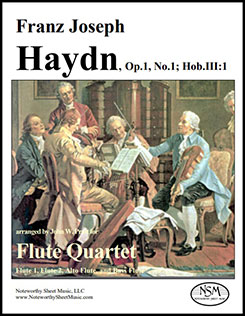 Quartet, Op.1, No.1, by Franz Joseph Haydn
Quartet, Op.1, No.1, by Franz Joseph Haydn
Arranged for Flute Quartet by John W. Pratt (originally for strings)
Score and Parts for Flute 1, Flute 2, Alto Flute, and Bass Flute, PDF $15.99
The earliest quartets of Franz Joseph Haydn are not precursors of the later works wherein he developed the form and style of the classical string quartet, but rather divertimenti written for four friends when he was about 25. Most of these early works have five movements: fast, minuet/trio, slow, minuet/trio, fast; and their slow movements feature beautiful, elaborate, gently accompanied melodies.
The divertimento style and instrumental character of these early pieces does not evoke strings specifically or necessarily, and thus arrangement for other instruments is natural and might expand enjoyment of these wonderful first significant Haydn works to other players and audiences. In John Pratt’s arrangement of Haydn’s Op.1, No.1 (Hob.III:1), most of the range issues for flutes were solved by transposition up a step, a few more by exchanging the two inner voices in places or by octave transpositions. This lovely, effective arrangement is for a flute quartet consisting of two concert flutes, alto flute, and bass flute; the edition is available exclusively from Noteworthy Sheet Music.
Score, 19 pages; Parts for Flute 1, Flute 2, Alto Flute and Bass Flute, 5 pages each; Total, 46 pages.
PreviewHaydn - Trio, Hob. XV:18 - arr. Woodwind Quartet
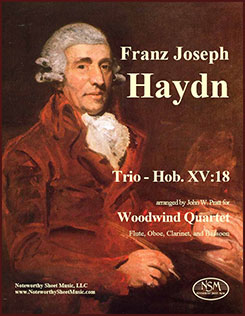 Trio, Hob. XV:18, by Franz Joseph Haydn
Trio, Hob. XV:18, by Franz Joseph Haydn
transposed to B-flat major and arranged for Woodwind Quartet by John W. Pratt
Score and Parts for Flute, Oboe, B-flat Clarinet, and Bassoon; PDF $20.97
As noted in the arranger’s forward to the edition, the later piano trios of Franz Joseph Haydn (1732-1809) are superb music, but because they were written for excellent pianists and weak string players, they are dominated by the piano part. This imbalance among the parts actually makes the trios highly amenable to and effective in arrangement for woodwind quartet. Written after Haydn’s first visit to London, the Piano Trio in A major, Hob. XV:18, was first published in 1794. The first of its three movements, a flowing Allegro moderato, is unified by ingenious use of the three-note motif opening its cantabile main theme. The lovely middle Andante, in ABA form and 6/8 meter, features some luxurious ornamentation and proceeds attacca to the spirited and humorous Allegro finale. The resources of a woodwind quartet are well suited to the musical ideas of this trio, and the arrangement adapts Haydn’s piano, violin, and cello lines wonderfully to the range and sonority of the instruments used: flute, oboe, B-flat clarinet, and bassoon. This adaptation is facilitated by transposition from Haydn’s original key of A major to B-flat major. We provide parts plus a score in concert pitch.
Click to listen to computer-generated audio samples from the score; audio clips from movements I (m44.4 - m64.3), II (m0 - m4.5 & m49.6 - m54.5), and III (m36.2.2 - m48) are separated by brief pauses.
Score in concert pitch, 21 pages; Flute part, 8 pages; Oboe part, 6 pages; B♭-Clarinet part, 5 pages; Bassoon part, 5 pages; Total, 52 pages.
Preview